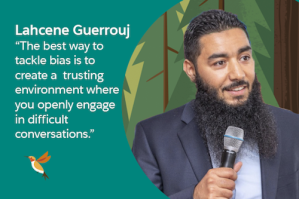When it comes to ensuring equality, diversity and inclusion at work, there are many topics to consider. Every business will face different challenges based on their location, workforce and history. But all companies need to consider how they address issues related to systemic discrimination and ensure they have a plan to identify and eliminate implicit biases at every level.
These are not easy conversations – some may feel uncomfortable naming a group of people from the same ethnicity. Actually, the term ‘race’ can be considered taboo in some areas. For instance, in France, since 1978, the collection and computerised storage of race-based data is not authorised. Additionally, in Germany, when literally translated ‘race’ is more used to describe the breed of animals, hence already placing a bias on the topic.
It makes it even harder to have conversations that will address bias and increase equality and diversity in the workplace.
To address this complex topic, we spoke to Lahcene Guerrouj, EMEA Content Strategy Manager. Lahcene has worked with people from different countries, cultures, ethnicities and religions over the past 15 years, and he is always thinking about ways to define/identify discrimination, reduce bias, and increase diversity.
We often hear about diversity in the workplace. Why is it so important?
Lahcene Guerrouj (LG): Working with people from different backgrounds gives you another perspective. A diverse workforce presents a unique opportunity to bring together people with various locations, schools of thought, styles of learning, and ways of managing information. When knowledge and experience are shared in this way, good things happen. Having another cultural perspective can allow me to see a topic from a new angle, encourage me to think about it in new ways, or help me to see the bigger picture. The result is a clearer view of the challenges we face – and a better outcome for the customer.
Building diverse teams is about more than gender or skin colour. Even when we share someone’s ethnicity and culture, there may still be differences, ie: different religion, sexual orientation, age, or even different job industry. Marketing and Engineering teams, for example, have very different mindsets. I have worked on projects where we had both perspectives in the room, and the synergy between them brought great ideas to the table.
Your workforce should reflect the diversities in the world. We are trying to serve a diverse customer base, from different countries, cultures, backgrounds, languages and religions. That needs to be reflected in the teams we build. Things may not work perfectly all the time, but when diversity is well-managed, it leads to positive outcomes.
How does implicit bias affect diversity in a corporate setting?
LG: Implicit bias refers to stereotypes and preconceptions that affect our decision-making in subtle and unconscious ways. It’s one of the biggest pitfalls in corporate organisations. It impacts employees, and it impacts businesses, too. Putting together a cross-functional team isn’t easy to start with. The additional challenges posed by international barriers, and now remote working, can make building a high-performing team harder than ever. Implicit bias can add another level of tension.
Ideally, we want everyone to be their true self and to open up. If a person shows signs of implicit bias, it may destroy the foundation of trust and openness – that’s why education around the impact of bias is so important.
What are the negative impacts of implicit bias on communities?
LG: Implicit bias can be hard to record, document, and sometimes see. But if you talk to someone from a minority group– regardless of their culture, background, or religion – they’ll often tell you that they need to do four times more work to get the same recognition as their counterparts. This sounds shocking, but it’s a common situation. Throughout my career, I’ve heard similar feedback from a wide range of colleagues/people. Often when they deliver a piece of work, they feel that it is interpreted or assessed differently. In addition to the negative impact on work and morale, implicit bias impacts our decision-making – without knowing it, it can influence who we decide to hire, or promote, or how we interact in the workplace.
What advice would you give to companies to address these implicit biases?
LG: Training on implicit bias is essential, but it is only one part of the solution. The best way to eliminate bias is to create a safe and trusting environment where you can have difficult conversations when needed. It’s imperative that employers work to ensure that their company prioritises inclusion and diversity at all levels of the organisation, especially leadership. An excellent way to measure the effectiveness of diversity initiatives in the workplace is to look at the leadership team. Not at their backgrounds but their actions. Leaders are the ones who champion equality among different groups, and who build the company’s culture.
What are the dangers of unconscious bias and stereotypes in the workplace?
LG: Even with the best intentions in the world, It generates an environment prone to division and exclusion. If you are looking to build a top-performing team, this will have the opposite effect. It could happen without realising the root cause. The longer we wait to address those the worse it can get.
We are living in a time with a lot of changes which need to be managed. According to Tuckman’s stages of group development, during changes, the team goes through the following stages:
- Forming,
- Storming,
- Norming,
- Performing.
To migrate from the Storming stage to Norming, teams need to build trust. This would be highly challenging to help the team progress there if we do not mitigate biases right at the beginning.
It can also lead to microaggression:
“Microaggressions are brief and commonplace daily verbal, behavioural, or environmental indignities, whether intentional or unintentional, that communicate hostile, derogatory, or negative racial slights and insults toward people of colour. Perpetrators of microaggressions are often unaware that they engage in such communications when they interact with racial/ethnic minorities.” (source: article published in the American Psychologist by a group of teachers from Teachers College, Columbia University).
For companies, the danger is that they will hinder their growth by not having the best workforce. I have seen teams that are operating with a lot of tension and who are not performing well together. I have also seen groups not diverse enough with limited perspective, and unable to deliver the best results. Everyone loses.
Implicit bias affects individuals at every level of a company. Do you believe that it improves or gets worse at the highest level?
LG: Leaders are not immune – I’ve seen leaders display not just unconscious, but also conscious, bias. I used to believe that education breeds openness and that people who behaved in a discriminatory way were the ones with the least education. It is not always true. Biases can exist anywhere: in recruitment, in sales, in operations, right up to VP level – and even managing directors.
When I have witnessed people who are successful and highly educated display those biases, it has been hard to process. The first time I experienced it in my career, these actions came from someone in upper-level management. I was very young, and I did not know how to respond; should I report it? Push back against it? He was very senior. I am not proud of this moment.
Now, I would like to help people recognise how critical this issue is. I don’t have all the answers. I am always trying to identify my own biases and work on eliminating them.
Yes, it is getting better because now, we can now talk about it.
How can companies encourage individuals who experience discrimination to speak out?
LG: Companies need to ask themselves: have we created an environment where these conversations are possible? Are there channels to report discrimination – such as anonymous hotlines, or representatives from third parties? If so, are they well-promoted and accessible to everyone? If there is training, is it well put together and documented? Do these programs effectively highlight the differences between conscious and unconscious biases?
Diversity also plays a role in enabling people to speak out. Someone who experiences discrimination in the workplace may find it easier to disclose it to a leader who is from the same group or minority, so companies need to make sure that they have diversity at all levels. Rather than looking at the people who are currently on your team, think about who’s missing. If your workplace is predominantly male, you need to ask what you can do, as an organisation, to encourage women to join your company, and remove barriers to them rising to leadership roles. We need to ask ourselves, are we promoting the individuals who have the most potential to inspire growth in others?
Now I’m going to pose a question to you: are you looking into your own unconscious biases and working to broaden your perspective?
























